IDespite significant moves by growers into no-till and conservation tillage, the market for ground-engaging iron shows no signs of gray hair or long teeth. This is particularly true in regions growing GMO corn and in those areas affected by herbicide-resistant weeds.
Visiting with a number of product engineers and tillage company marketing representatives about future trends in tillage, today’s byword in their conversation is “productivity,” a term that hides a multitude of engineering challenges. But in all cases, tillage makers are seeing renewed interest in “moving soil” — whether to manage residue or to take out resistant weeds.
Beyond Turning the Soil
“Tillage used to be defined as making the soil as dark and as level as possible,” explains one product manager. Today the definition of tillage has to include:
- what to do with residue from 300 bushel Bt corn,
- the ability to get over a field in what seems to be an ever-decreasing weather window of opportunity,
- the ability to leave just the right amount of residue on top to manage moisture and erosion,
- and correcting or not adding to compaction problems in the field.
While wider equipment addresses the need for speed — particularly in this era of nearly

These photos of subsoiler points with the same number of acres behind them show the wear-advantages of hard-facing treatments (right) vs. stock point (left).
700-horsepower tractors — OEMs say they are reaching the limits on how to fold 70-foot and wider cultivators and their companion planters for transport. When it comes to compaction and wider equipment, the challenges are forcing engineers to look at newer and lighter materials and designs, which may not work as deeply as today’s tools.Another long-time “iron man” says, “We have the basic tools, but we’re going to see many tweaks and innovations to meet tomorrow’s challenges.”
Based on field studies that show existing disc rippers run at 16-inch depths, but do their best work at 10-12 inches, manufacturers are seeing a change in thinking from “how deep will it work” to “how deep do I need to work.” That will usher in tools like the Great Plains Turbo-Vator vertical tillage tool that operates shallower and wider with existing tractor horsepower for more efficiency.
Similarly, tools using the new smaller-diameter, high-speed compact discs such as those introduced two seasons ago by Amazone are gaining attention in areas where field residue must be dealt with in a hurry.
Another change in farming that increases the need for tillage equipment is the use of cover crops in areas moving from mono-crops to seasonal rotations. Cover crop residue must be incorporated for a proper seedbed for the next crop. In these cases, some form of tillage will be necessary in those situations, likely in the form of new hydraulically-operated offset finishing coulter gangs such as those introduced this year by Summers, which hearken back to traditional tillage tool designs. Additionally, shallow incorporation is necessary for the best environmental stewardship of phosphorus and potassium fertilizers.
Improving Soil Microbiology
Another trend driving tillage implement design is an industry-wide recognition that soil is more than an anchor for plants. It actually is the environment for up to “two cows’ weight” or so per acre of soil bacteria, as well as fungi and other microbes that play a significant part in plant productivity (there’s that word again.)
One seasoned observer I spoke with noted, “Years ago tillage was tillage and planting was planting. Today, they are all part of the same process.” His comments are borne out when you consider that last pass in the fall with mechanical tillage — regardless of how shallow — sets the stage for the no-till planter in the spring and that affects soil/seed contact that is so vital to good stands.
Look for more engineering of tillage tools as companions of planting equipment as growers continue to adopt more integrated systems based on protecting the microbial environment in their fields. “The tools of the future will look similar to what we have today, but how we use them will be determined more and more by our efforts to protect the soil microbiology,” says one market manager for a Canadian tillage tool maker.

The new Turbo-Vator from Great Plains runs 8-9 inches deep to leave a “one pass” seedbed in the spring. While vertical tillage requires a change in overall field management, for productivity comparison, a 400 horsepower tractor can pull a 36-foot tool of this type or a 16-foot disk ripper.
This move to “field biology” is also responsible for a growing number of equipment dealers across the U.S. hiring field agronomists to work with their customers in maximizing the productivity of a farm with the proper and timely use of various tillage and planting tools. While “selling iron” may have meant success in the past, future success will rest on providing producers with one-stop shopping to meet complex field management decisions.
Leveraging Metallurgy
Any time you pull metal through the soil the metal will eventually wear out. How fast that occurs depends on the speed with which you pull, the angle of movement, soil texture and the presence of rocks or sand.
Most tillage tool makers say field speeds are likely to increase from today’s 6-8 mph to rates of 10-12 mph as growers become more productive. That will mean more wear on parts moving through the soil.
To date, ground-engaging tools provided by most manufacturers share a fairly similar metallurgy, one that gives the best long-term performance at a price producers will pay. In cases where excessive wear may be the norm, hard facing has provided a solution for many OEMs. That trend may be changing, however, as a number of the tillage designers we spoke with say “custom alloys” (based on regional needs) for points and shovels may begin to gain favor as growers demand less down time and more productivity. Chrome-boron alloys are already popular as standard equipment on many tools, such as coulters and subsoiler points.
In addition, producers may become more aware of the actual wear on their tillage equipment as some engineers and product developers foresee systems that will provide real-time wear readouts from the implement to the tractor cab. Tool wear is sure to become more of a problem, particularly as field speeds climb.
Dealers who lead the way to solving customer wear problems with specialized tools will profit from this trend that is sure to happen — sooner rather than later.
Dig in to Sell Iron
A number of seed and chemical companies and fertilizer manufacturers are pointing their grower customers to the importance of the soil and soil microbiology in successful crop yields.
In fact they are going to the expense of digging soil profile pits in grower-cooperator fields to demonstrate what happens when crop roots encounter compaction layers and various soil types in their root zone.
The results are astounding when matched with yield maps of the area in which the pits are dug. The benefits of shattering that compaction with either a one-time deep tillage or a year-by-year management plan that deals with compaction through seedbed preparation and shallow tillage can be measured in yields and per-acre dollars generated.
While brochures and shiny new equipment can make a lot of sales, having an agronomist working in your area, showing producers how they can benefit by removing compaction layers for the 15% of the crop they never see, can plant the seed for looking at brochures and shiny new paint.






